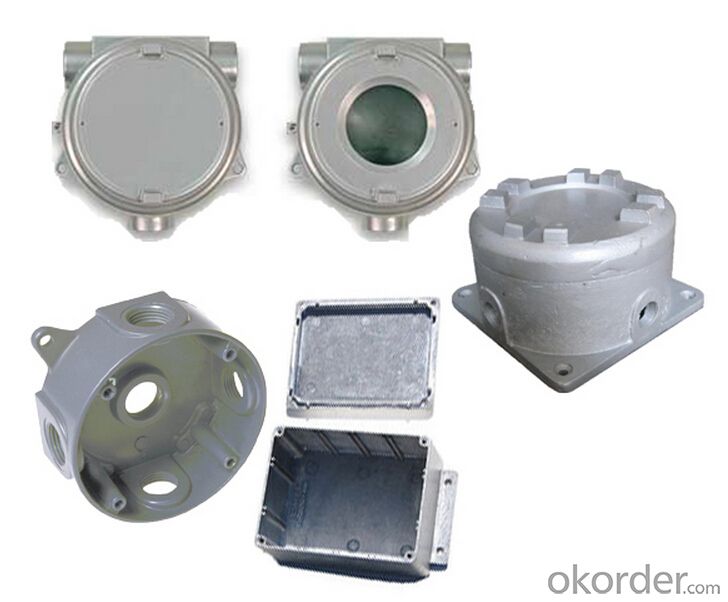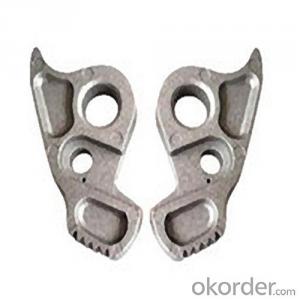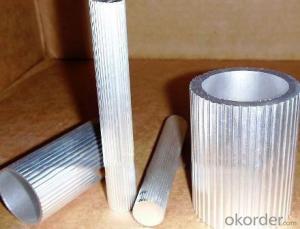Extrusion Profiles Aluminum - Zamak Die Casting with ISO Certificated and High Quality
- Loading Port:
- Guangzhou
- Payment Terms:
- TT OR LC
- Min Order Qty:
- 1000 pc
- Supply Capability:
- 100000 pc/month
OKorder Service Pledge
OKorder Financial Service
You Might Also Like
Structure of Zamak Die Casting Description:
Zamak Die Casting is applied to the business with mature production skills and complete casting parameters. The fact is aluminum cold chamber die casting is generally and acceptable by all customers. Aluminum Alloys Applied to Us: ASTM: A413, A356, A360, A380, A383…etc. JIS: ADC1, ADC3, ADC6, ADC10, ADC12…etc.
Zamak Die Casting is a metal casting process that is characterized by forcing molten metal under high pressure into a mold cavity. The mold cavity is created using two hardened tool steel dies which have been machined into shape and work similarly to an injection mold during the process. Most die castings are made from non-ferrous metals, specifically zinc, copper, aluminium, magnesium, lead, pewter and tin based alloys. Depending on the type of metal being cast, a hot- or cold-chamber machine is used.
2.Main Features of the Zamak Die Casting:
.High pressure, high temperature, high speed.
.Better performace, complex shape, thin-walled precision parts.
.Smoth surface, various surface treatment.
.Mechanical properties and wear resistance.
3. Zamak Die Casting Images


4. Zamak Die Casting Specification
Product Class: | zamak die casting | ||
Material: | Aluminum & Aluminum alloy A360, A380, A356, ADC12,ADC10, | ||
weight | 0.02-15 kg ( Tolerance :+/- 0.5mm) | ||
Manufacture Process | 1) Process: zamak die casting/Metal alloy die casted parts /gravity casting products 2)Secondary Machining: CNC turning, milling, drilling, grinding, assembly to Packing 3) Surface Finish: Chrome plating, sandblasting, painting, anodizing, powder coating, electrophoresis |
5.FAQ
①How about your company?
We are a state-owned company. The quality is guaranteed.
②How about delievery time?
It will be one month
③MOQ?
MOQ is 1000pieces
- Q: 6063 aluminum manufacturers fail to notice how to write a written report
- Hello!You can search the Internet for unqualified written reports, and see if there are similar onesYou see, you sign the contract, which has not marked this point, say how to deal with substandard, you just need to copy the above, make a little change on the lineAsk if your manufacturer has a template. How do you write it?In fact, this is not what the provisions of how to write, as long as the two agreed to make things clear, double admit something on the line, cover double seal, all right, hope to be able to help you, thank you for the adoption.
- Q: Can aluminum profiles be used for balustrades?
- Yes, aluminum profiles can be used for balustrades. Aluminum is a lightweight and durable material that is commonly used in construction for its strength and resistance to corrosion. It is also easy to shape and work with, making it ideal for creating various designs and styles for balustrades. Additionally, aluminum profiles can be powder coated or anodized to provide a decorative finish and enhance its durability. Overall, aluminum profiles offer a practical and aesthetically pleasing solution for balustrades in both residential and commercial settings.
- Q: What are the various materials that can be combined with aluminum profiles in construction or manufacturing?
- <p>Aluminum profiles can be combined with a variety of materials to enhance their functionality and durability. Common materials include steel for added strength, plastics for lightweight components, and various types of glass for transparency and aesthetics. They can also be paired with rubber or silicone seals for weatherproofing, and wood for a warmer, more natural aesthetic. Additionally, aluminum profiles are often used with other metals such as copper or brass for electrical conductivity or corrosion resistance. The choice of material depends on the specific application, desired properties, and design requirements.</p>
- Q: What are the advantages of using aluminum profiles in the marine industry?
- Using aluminum profiles in the marine industry provides several benefits. Firstly, aluminum is highly resistant to corrosion, unlike steel and other metals. This makes it a reliable and durable material for marine applications. Secondly, aluminum profiles are lightweight yet strong, making them easy to handle and install. This reduces the overall weight of the vessel, improving fuel efficiency and increasing payload capacity. Additionally, aluminum profiles are highly customizable, allowing for complex structures and intricate designs. This flexibility provides endless possibilities in marine construction. Furthermore, aluminum is a sustainable material as it is 100% recyclable and retains its properties even after multiple recycling processes. This aligns with the growing demand for sustainable practices in the industry. Lastly, aluminum profiles offer excellent thermal conductivity, reducing the risk of overheating and enhancing the performance of marine engines and equipment. In conclusion, the advantages of using aluminum profiles in the marine industry include corrosion resistance, lightweight yet strong characteristics, customizability, sustainability, and excellent thermal conductivity. These benefits contribute to the efficiency, durability, and environmental friendliness of marine vessels and structures.
- Q: Can aluminum profiles be used for modular systems or frameworks?
- Yes, aluminum profiles can be used for modular systems or frameworks. Aluminum profiles are lightweight, durable, and can be easily assembled and disassembled, making them a popular choice for constructing modular systems or frameworks. They offer flexibility in design, allowing for easy customization and reconfiguration as needed. Additionally, aluminum profiles have high strength-to-weight ratio, corrosion resistance, and are available in various shapes and sizes, making them suitable for a wide range of applications in modular systems and frameworks.
- Q: This question asks for guidance on selecting a trustworthy supplier of aluminum profiles used in construction.
- <p>To choose a reliable supplier of aluminum profiles for building construction, consider the following: Check their industry reputation and customer reviews. Ensure they have the necessary certifications and quality standards compliance. Evaluate their product range and quality, comparing different suppliers' offerings. Assess their delivery times and reliability. Consider their after-sales service and warranty provisions. Finally, get quotes from multiple suppliers and compare prices while ensuring quality is not compromised.</p>
- Q: What are the mechanical properties of aluminum profiles?
- The mechanical properties of aluminum profiles are influenced by factors such as alloy composition, heat treatment, and manufacturing processes. Aluminum profiles generally exhibit excellent strength-to-weight ratio, making them lightweight yet strong. They have good corrosion resistance, making them suitable for various applications in different environments. Aluminum profiles also have good formability, allowing them to be easily shaped and fabricated into desired designs. They have high thermal and electrical conductivity, which makes them useful in applications such as heat sinks and electrical conductors. Additionally, aluminum profiles have low density, which contributes to their lightweight nature. Overall, the mechanical properties of aluminum profiles make them versatile and widely used in a range of industries including construction, transportation, and electronics.
- Q: Are aluminum profiles compatible with other materials for construction purposes?
- <p>Yes, aluminum profiles can be used in combination with other materials in construction. They are often paired with steel, glass, and various plastics due to their lightweight, durability, and corrosion resistance. Aluminum's ability to be easily joined and its compatibility with different finishes make it a versatile choice for construction projects.</p>
- Q: Can aluminum profiles be an alternative to steel in certain applications?
- Certainly, aluminum profiles have the potential to serve as a feasible substitute for steel in specific applications. Aluminum profiles possess numerous advantages over steel, rendering them suitable for particular use cases. Primarily, aluminum profiles exhibit a significantly lighter weight compared to steel, which proves advantageous in industries where weight reduction is crucial, such as aerospace or automotive applications. The reduced weight of aluminum profiles also facilitates their handling and installation in diverse construction projects. Secondarily, aluminum profiles boast exceptional corrosion resistance properties. Unlike steel, which is susceptible to rust and corrosion, aluminum naturally develops a protective oxide layer on its surface, providing long-term safeguarding against environmental elements. This renders aluminum profiles a preferred option in outdoor applications or environments exposed to high humidity or chemicals. Additionally, aluminum profiles possess a higher strength-to-weight ratio in comparison to steel. Although steel generally exhibits greater strength, aluminum profiles can still offer adequate strength for numerous applications while remaining significantly lighter. This attribute renders aluminum profiles suitable for structures requiring substantial strength but necessitating a lightweight characteristic, such as building facades or bridges. Moreover, aluminum profiles possess superior thermal conductivity in relation to steel. This makes them an excellent choice for applications mandating efficient heat dissipation or thermal management, such as heatsinks or heat exchangers. To summarize, while steel maintains its status as the preferred choice in many applications due to its strength, aluminum profiles can serve as a viable alternative in specific scenarios. Their lightweight nature, corrosion resistance, high strength-to-weight ratio, and thermal conductivity render them ideal for particular industries and projects.
- Q: This question asks for methods to protect aluminum profiles from corrosion and damage during the processes of transportation and storage.
- <p>To prevent corrosion and damage to aluminum profiles during transportation and storage, follow these guidelines: 1. Keep aluminum profiles dry and clean. Moisture and dirt can accelerate corrosion. 2. Use protective packaging, such as plastic wrap or padded covers, to shield profiles from physical damage and moisture. 3. Store profiles in a cool, dry place away from direct sunlight and corrosive substances. 4. Stack profiles with appropriate padding between layers to prevent scratching. 5. Avoid overloading during transportation and ensure secure fastening to prevent movement and potential damage. 6. Regularly inspect stored profiles for signs of corrosion or damage and address any issues promptly.</p>
Send your message to us
Extrusion Profiles Aluminum - Zamak Die Casting with ISO Certificated and High Quality
- Loading Port:
- Guangzhou
- Payment Terms:
- TT OR LC
- Min Order Qty:
- 1000 pc
- Supply Capability:
- 100000 pc/month
OKorder Service Pledge
OKorder Financial Service
Similar products
Hot products
Hot Searches
Related keywords


























